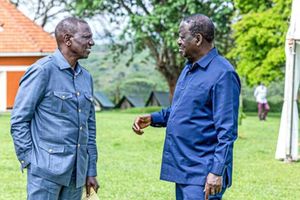Why you still can’t get fuel despite Uhuru's Sh34bn intervention

Boda boda riders queue for fuel at Shell fuel station in Kapenguria, West Pokot on April 5.
The fuel shortage crisis continues in several parts of Kenya with many filling stations unable to serve hundreds of motorists streaming in to buy the crucial commodity.
This is happening though President Uhuru Kenyatta on Monday approved a Sh34.4 billion allocation to the Petroleum Development Levy Fund (PDLF) to stabilise fuel prices in a supplementary budget.
Petroleum Principal Secretary Andrew Kamau had also promised the crisis would “end by Wednesday” following a payment of Sh8.2 billion to oil marketers, part of the Sh13 billion outstanding arrears owed to the companies.
He had argued that the fuel shortage was largely caused by panic among motorists who were buying fuel at larger quantities than they normally would, stretching the capacities of petrol stations.
“It is a pity that we have decided to have a run on the stations but once everyone has filled their cars and jerricans I suspect by Wednesday the stations will have fuel but they will have no queues,” he said.
The Energy and Petroleum Regulatory Authority (Epra) said oil firms had refused to evacuate their fuel cargo from depots due to delays by the government to release the subsidy money.
International prices
“The recent escalation in international prices has resulted in huge differences between the actual calculated and the stabilised pump prices,” Epra said.
“There have been delays in remitting compensation from the stabilisation fund and this has resulted in a number of [oil marketing companies] holding back sales to the local market.”
But three days later, the fuel shortage continues to bite. So what is going on?
An oil executive told the Nation that the late payment of the subsidy was just one of the unresolved issues and that Monday’s payment will not immediately end the fuel shortage.
He said the money is first wired to the fuel importer before being released to oil marketing firms, a process that takes time.
Kenya’s fuel is imported by one firm at a time. It is the company that wins the tender to import petroleum products through the Open Tender System (OTS) for a specific purchasing cycle.
The supplier then distributes the fuel to oil companies at the same price after factoring in other costs such as levies and taxes.
“It is a complex process. It can take a few days before we finally receive the money,” the oil executive said.
He added that the high global crude oil prices have led to higher import costs and that the fuel prices set by Epra on March 14 did not cover this increase.
“The real problem is the current prices set by Epra. Crude oil prices have gone up globally but the new prices don’t fully cater for this, which means we are selling at a loss, which has put us in a bad position financially,” he said.
Small oil dealers
It is expected that once the companies receive the money, they should be able to get fresh stocks from Kenya Pipeline Company (KPC) depots, and that will also allow small oil dealers to restock.
Small oil firms, which form a vast network of retail stations across the country, rely on fuel supplies from larger oil firms.
The Nation could not reach KPC to confirm whether oil firms have resumed taking fuel stocks from its depots following release of the subsidy money.
On Saturday, KPC said it had enough fuel to serve the country.
“KPC’s current stock position in all their facilities as at today noon indicates that there are over 69 million litres of super petrol, more than 94 million litres of diesel, more than 13 million litres of kerosene and over 23 million litres of jet fuel available,” it said.





